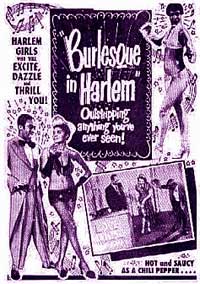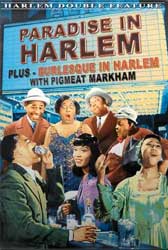 The most surprising aspect of Burlesque in Harlem (1954) is the high quality of the singing acts. Burlesque was never just striptease but was equal parts singers & comedy skits.
The most surprising aspect of Burlesque in Harlem (1954) is the high quality of the singing acts. Burlesque was never just striptease but was equal parts singers & comedy skits.
But as a generality the comics were failures who ended up working as "the baggy pants clowns" because they weren't good enough for radio, television, or high-end niteclubs; & the singers tended to be just as deservedly obscure.
Not so if the entertainers were from up in Harlem, where even the burlesque dancers have great skills, the blue comic famously funny, & the singers good enough for any quality musical review.
Black Burlesque was never as much at the fringe of entertainment as it was for white burlesque. It held longer to the Vaudeville traditions with Harlem Renaissance associations. Burlesque showgirls were part of Cab Calloway's troupe & were featured regularly at the Cotton Club & the Savoy Ballroom & the Apollo Theater.
Famous burlesque producer Billy Minsky called what went on in Harlem "progressive burlesque," & it's what he tried to do when he had a star with the break-out potential of Gypsy Rose Lee. Many besides Minksy insisted on a respectable veneer for adult entertainment, but the average burlesque house wouldn't justify that respect. These Harlem acts do deserve respect.
Harlem was a major center of white as well as black burlesque, vying with Greenwich Village & Coney Island for the adult entertainment crowds. There was considerable cross-fertilization of burlesque as art, as entertainers always emulate one another or copy a good thing, dancers no less than comics.
But it was certainly not a case of black burlesque imitating white. The leading exotic dancer in the world may well have been Josephine Baker, & when the white striptease artist Sally Rand gained cross-over success as mainstream entertainment, she did so with the fan-dance "borrowed" wholesale from Cotton Club burly-q Amy Spencer, celebrated by Cab Calloway in his song "The Lady with the Fan."
So in essence we're dealing with a higher grade of entertainment from word go when it came to black burlesque, so whether it's the baggy-pants clown or the singing master of ceremonies as traditional to burlesque as the strippers, these turn out to be genuine talents rather than the dregs.
Burlesque in Harlem has been wrongly overlooked as an important black-cast film, it's misleading sexploitation veneer getting it shunted aside. It deserves better.
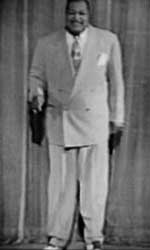 The emcee Dick Barrow welcomes us to the show which he alludes to as "Barrow's Burlesque" which makes me suppose it really was his production.
The emcee Dick Barrow welcomes us to the show which he alludes to as "Barrow's Burlesque" which makes me suppose it really was his production.
Barrow was a decent bluesman, who sings two numbers in the course of the film. "Juice Head Baby" with the lyric, "She drinks whiskey like walter," is good stuff. He later sings "Wake Up Baby." The "burlesque" angle might be the slightly risque nature of the lyrics, but that's not at all uncommon of blues, & Barrow's material is merely good stuff.
The first act introduced by Barrow is the Taylorettes. They will have two dance numbers, the opening tapdance routine, & later on the so-called "Blues March" which resembles calisthetics more than dance.
They're named for the film's costume designer & choreographer Betty Taylor. Their chorus line tapdance number isn't bad, & puts a Harlem Renaissance slant on the usual manner of opening a burlesque show with a follies-style parade of beautiful women. Their "blues march" isn't as impressive.
Intriguingly, though they're a "mass" of dancers with no evident star among them, the opening credits list the individual troupe members, which wasn't often done for a chorus line, so they may have had a reputation in Harlem. They may well be the same troupe that performed as the Markham Dancers when booked into venues with Pigmeat Markham.
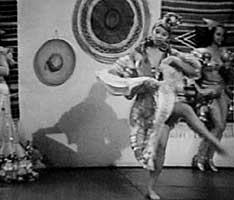 The first of the exotic dancers comes on immediately after the opening with the Taylorettes.
The first of the exotic dancers comes on immediately after the opening with the Taylorettes.
She has no introduction but she's Gloria Howard, billed in the cast credits as "The Atomic Bomb." She's a Spanish-styled dancer in something of a flamenco dress but with lots of skin showing, backed up by two wiggling cutie percussionists.
Gloria does not do striptease, but is a fiery performance without pealing. Even strip acts were rarely about nudity & more about the tease, but Gloria goes nowhere near that. We'll have to wait a couple more acts before seeing striptease art per se.
After Gloria, a slim song & dance man performs. For some bizarre reason this guy appears in a couple of cast lists as "Huckabuck Jones," which must've originated as a joke that someone at imdb accepted as a real person. No such name appears in the film's cast list, as this is Jo Jo Adams, one of the headliners.
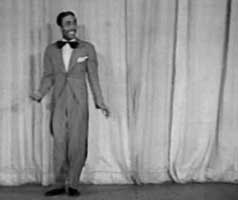 Sometimes billed as "Doctor Jo Jo," he was jump-jazz singer of the '40s & '50s well known in black clubs of Harlem & Chicago's southside. Sometimes billed as "Doctor Jo Jo," he was jump-jazz singer of the '40s & '50s well known in black clubs of Harlem & Chicago's southside.
He sings "I Like to Huckabuck," & he delivers a fine rendition of an urban dance called the huckabuck. The dance was popularized in 1949 with a chart-hitting song called "The Huckabuck," & the dance became a minor craze in the early '50s.
But it had been around a good while longer; Bessie Smith sings about dancing the huckabuck all night long in Wesley Wilson's 1933 song "Gimme a Pigfoot & a Bottle of Beer."
Jo Jo's number is truly a song for the burlesque, as the huckabuck was also a sexual position with the woman practically standing on her head & shoulders, & the guy doing it from a standing position. As Jo Jo sings it, it could be only the dance.
Jo Jo was influenced by Cab Calloway's clothing style, with an oversized bow tie & a jacket with tails that nearly reach the floor. After this number he immediately has a second set, strutting something resembling the apache dance with an equally slim beauty, miming a cruel courtship as if between pimp & prostitute.
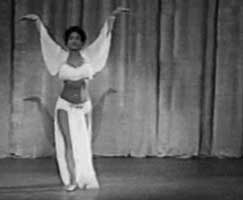 Jo Jo is followed by Barrow doing his second blues number, then by burly-q Gertrude "Baby" Banks. She's one of only two dancers who is explicitely given an introduction, the whole film being strangely shy about informing the viewer who is who. Jo Jo is followed by Barrow doing his second blues number, then by burly-q Gertrude "Baby" Banks. She's one of only two dancers who is explicitely given an introduction, the whole film being strangely shy about informing the viewer who is who.
She dances to the Duke Ellington jungle-beat arrangement of Cole Porter's "Night & Day," wearing a white costume that looks quite elegant though it's a standard burlesque type of bikini with added flags around the bikini-bottom, extra bits that can be removed one by one without actually gettin' naked.
She's got real dancing skill & a strong looking body. The second half of her performance, which speeds up, has moves that come damned close to being "the twist" & "the swim," making one wonder if the fad dances of the early '60s were already old dances in Harlem or originating among never-credited burlesque queens.
I've been loving the hell out of this show despite the poor sound quality & overall cheapness. But I'm about to be led from entertained to impressed. Mabel Hunter follows Baby Banks.
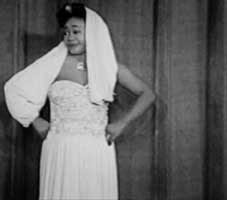 Mabel was a hefty yet beautiful woman, a first-rate singer & a delightful comedienne. Mabel was a hefty yet beautiful woman, a first-rate singer & a delightful comedienne.
Her positioning after one of the show's chief babes is intentional, with the idea that a jolly big singer inherently parodies gorgeous dancing babes, & Mabel milks this expectation with some dancing too. A second hefty gal will end this variety hour, & she too will follow a headline dancer, & will parody some of of the strip artist's moves.
For Mabel's first appearance she's in a white evening gown as she does a "rap number" called "Fat Man Blues" which is very amusing, about how she likes men, even fat men can be thrilling, but how annoying it can be if some ugly-ass s.o.b. she's condescended to be interested in up & decides she's not good enough.
She returns later in a black evening gown to sing "I Wanna Rock" which is jump-jazz of the Louis Jordan school, with all the features of rock 'n' roll in place. She'll return a third time to sing another rockin' jump-jazz number, "He's Knocking But I Can't Let Him In." As this jump-jazz number develops, she unexpectedly lifts up her evening gown to reveal the most absurd striped pants, & spoofs a burlesque dance.
She's the only performer of the whole lot who gets three sets, undoubtedly because it was obvious she's just about the best on the bill. Damn but she should be better remembered as a great jazz singer & formative rocker, but this film seems to be the only chance to see how good she was.
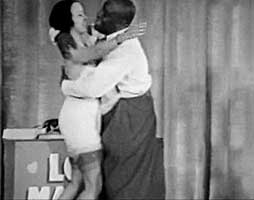 Burlesque in Harlem advertised itself as starring Pigmeat Markham, undoubtedly the best known name on the bill. He's the baggy-pants clown that all burlesque shows required, except he's way, way better than baggy-pants clowns usually needed to be.
Burlesque in Harlem advertised itself as starring Pigmeat Markham, undoubtedly the best known name on the bill. He's the baggy-pants clown that all burlesque shows required, except he's way, way better than baggy-pants clowns usually needed to be.
Pigmeat's best known routine "Here Come Da Judge" was repopularized in the 1960s by Flip Wilson & soonafter coopted into the comedy show Laugh-in. He's a classic "blue" comic with a completely commanding stage presence.
He's such a big dude, if he were around Hollywood today he would probably get typecast as a psychotic gangster because of his imposing presence, but he was by nature a man of extravagent jests.
He only has this one set for the film & it's a routine called "The Love Making Bureau." The routine co-stars Vivian Harris (who years before introduced the "Here Comes the Judge" skit with Pigmeat). Vivian was a singer-commedienne known as "the voice of the Apollo" as she was the Apollo Theater announcer for many, many years.
She starred in many black stage musicals, & when a youngster starting out in a chorus line, she was in Runnin' Wild (1923), the musical that introduced the Charleston to the world, making her one of the first people anywhere on earth to dance the Charleston. Her sister was the vivacious Edna Mae Harris who plays the jazz-lovin' gal in Green Pastures (1936).
In the Love Making Bureau routine, Pigmeat has been hired by a scam artist (George Willshire) to work as a sex instructor. But every time Pigmeat's getting revved up & ready to go, Willshire interupts to collect another $5 from Vivian, spoiling Professor Pigmeat's timing until he's frustrated as all heck.
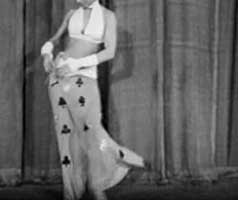 After Pigmeat, it's time for a striptease. Barrow again fails to provide an introduction, but this is Princess D'Orsey, a lovely Josephine Baker style retro-flapper.
After Pigmeat, it's time for a striptease. Barrow again fails to provide an introduction, but this is Princess D'Orsey, a lovely Josephine Baker style retro-flapper.
She does two numbers back to back. The first has her dancing in a flouncy dress & somewhat silly feathered hat. The performance is cuter than it is sexy, perhaps intended to be little-girlish.
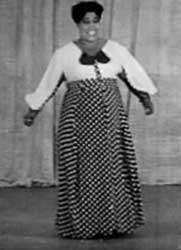 After a quick costume change into a more sensual gown which has playing-card symbols on it, she does a classy partial strip until she's dancing only in bikini, heels, & gloves. After a quick costume change into a more sensual gown which has playing-card symbols on it, she does a classy partial strip until she's dancing only in bikini, heels, & gloves.
Like Josephine Baker, she manages to retain dignity & gracefulness & is quite the beauty.
Luella Owens performs next, an even bigger woman than Mabel Hunter. She's wearing an unflattering tent of a dress, but nevertheless possesses stage charisma.
She's a fine, fine singer, performing the splendid blues number "It Takes a Dark Brown (To Really Lay Your Lovin' Down)."
Following Luella are two men billing themselves somewhat foolishly as "Slip & Slide." They consist of a little guy & a really tall guy who are first-rate tapdancers, for up Harlem way they had the best.
The little guy (Slip?) includes in his routines a clever bit involving a tapdance performed while seated in a chair. His partner does some corkscrew twirls & has incredible gracefulness for such a big man.
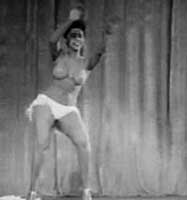 Slip & Slide are followed by the Emcee doing his jump-blues number, then comes Tarza Young, a top of the line striptease artist. Slip & Slide are followed by the Emcee doing his jump-blues number, then comes Tarza Young, a top of the line striptease artist.
Somewhat unfortunately her costume is very similar to that worn by Baby Banks. There's nothing wrong with the costume, but these two women should've dressed differently.
There's no sense that this show was really flmed at one time as an actual variety night, so Baby & Tarza may not have known until the film came out that they both wore white bikini outfits with extra flags attached for easy removal.
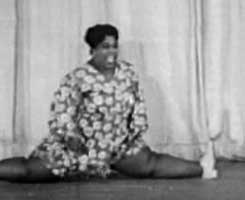 Tarza is a big-busted gal who once she's down to just the bikinki dances fiercely & well. Since only she & Baby got individual introductions, I assume they were headliners of the time. Certainly no one would be apt to complain! Tarza is a big-busted gal who once she's down to just the bikinki dances fiercely & well. Since only she & Baby got individual introductions, I assume they were headliners of the time. Certainly no one would be apt to complain!
For the closing act Luella Owens returns & gives us a rousing rendition of "(I'm Just a Big Gal) Doin' the Best I Can." It's a Louis Jordanesque jump-jazz number with the same spark of humor Jordan would've applauded.
Luella concludes her set with a burlesque dance that is comical only by right of her physical enormity. Her tent-dress is just as unflattering as her earlier outfit, but this one comes apart to become a short dress revealing lots of beefy thigh.
She dances up a storm & is really quite good, doing the splits as well as any slim gal. So in spite of the comedic intent, you gotta admit she's kind of awesome.
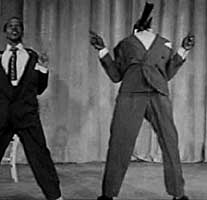 This critically ignored film is included on a double-bill dvd with Paradise in Harlem (1939), treated as an "extra" scarsely worth mentioning. Whenever Burlesque in Harlem does get a sentence or two of notice, it is often just to mention that it is the first all-black-cast feature-film for the sexploitation market of burlesque films popular in the 1950s. This critically ignored film is included on a double-bill dvd with Paradise in Harlem (1939), treated as an "extra" scarsely worth mentioning. Whenever Burlesque in Harlem does get a sentence or two of notice, it is often just to mention that it is the first all-black-cast feature-film for the sexploitation market of burlesque films popular in the 1950s.
But on that score, I don't find it sexploitive in anything but the title, & it's a small point, but at a little more than an hour it's not feature-length either.
Furthermore, an earlier black-cast film, Big Timers (1945), seems to involve burlesque acts. The performers are introduced as from a USO troupe, which they may have been, but with the obscure "all girl band," the amazingly talented "fat girl singer," the baggy-pants clowns, & the exotic dancer Tarzana (not the same as Tarza), it seems probable this rather than Burleque in Harlem was the first all-black-cast burlesque show on film, just not admittedly so.
Burlesque in Harlem is even so be the best document of black burlesque in Harlem of the era . And I believe it is an important film despite its neglect, not only in revealing an aspect of burlesque not terribly well recorded elsewhere, but also for the singers who cannot be seen in other footage.
Jo Jo Adams didn't strike me as the best on the bill, but he was famous in his day, & by this performance he can be partially assessed. Luella Owens & Mabel Hunter are such good singers that their obscurity has to be ascribed to their being fat. And the Dewey Pigmeat Markham routine is equally important for the history of comedy in America.
copyright © by Paghat the Ratgirl
|
